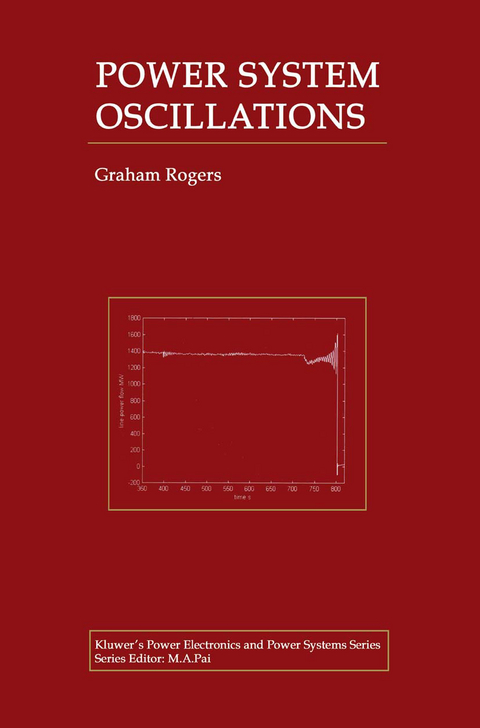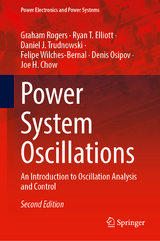
Power System Oscillations
Springer-Verlag New York Inc.
978-1-4613-7059-8 (ISBN)
- Titel erscheint in neuer
- Artikel merken
Since the late 60s when this phenomena was first observed in North American systems, intensive research has resulted in design and installation of stabilizing controls known as power system stabilizers (PSS). The design, location and tuning of PSS require special analytical tools. This book addresses these questions in a modal analysis framework, with transient simulation as a measure of controlled system performance. After discussing the nature of the oscillations, the design of the PSS is discussed extensively using modal analysis and frequency response. In the scenario of the restructured power system, the performance of power system damping controls must be insensitive to parameter uncertainties. Power system stabilizers, when well tuned, are shown to be robust using the techniques of modern control theory. The design of damping controls, which operate through electronic power system devices (FACTS), is also discussed. There are many worked examples throughout the text.
The Power System Toolbox© for usewith MATLAB® is used to perform all of the analyses used in this book.
The text is based on the author's experience of over 40 years as an engineer in the power industry and as an educator.
1 Introduction.- 2 The Nature of Power System Oscillations.- 1 Introduction.- 2 Classical Generator Model.- 3 Detailed Generator Model.- 4 Controlled Detailed Generator Model.- 5 Response to System Faults.- 6 Final Discussion and Comments.- 7 References.- 3 Modal Analysis of Power Systems.- 1 Introduction.- 2 Modal Analysis of Linear Dynamic Systems.- 3 Modal Analysis Applied to the Detailed Generator Case with and without Controls.- 4 Final Comments and Discussion.- 5 References.- 4 Modal Analysis for Control.- 1 Introduction.- 2 Transfer Functions.- 3 Synchronizing and Damping Torques.- 4 Summary and Conclusions.- 5 References.- 5 Power System Structure and Oscillations.- 1 Introduction.- 2 Coherent Generator Groups.- 3 Coherency in an Interconnected Power System.- 4 Tie Line Influence on Inter-area Mode Stability.- 5 Comments on System Structure.- 6 References.- 6 Generator Controls.- 1 Introduction.- 2 Speed Governor Controls.- 3 Excitation Controls.- 4 References.- 7 Power System Stabilizers.- 1 Introduction.- 2 Power System Stabilizer Basics.- 3 Stabilization of a Complete System.- 4 Evaluation of Power System Stabilizer Performance.- 5 Comments.- 6 References.- 8 Power System Stabilizers — Problems and Solutions.- 1 Introduction.- 2 Generator Torsional Oscillations.- 3 Power System Stabilizers at a Plant of Identical Generators.- 4 Comments.- 5 References.- 9 Robust Control.- 1 Introduction.- 2 Performance Specifications.- 3 Robust Control.- 4 Robustness of Power System Controls.- 5 Robust Control Design.- 6 Final Comments.- 7 References.- 10 Damping by Electronic Power System Devices.- 1 Introduction.- 2 System Performance without Electronic Controls.- 3 Static VAr Compensators.- 4 Thyristor Controlled Series Capacitor.- 5 High Voltage DC Link Modulation.- 6General Comments.- 7 References.- A1 Model Data Formats and Block Diagrams.- 1 Load Flow Data.- 2 Dynamic Data.- 2.1 Generator.- 2.2 Exciter System Data.- 2.3 Turbine/ Governor Data.- 3 HVDC Data.- 4 Case Data.- 4.1 Two-Area Test Case.- 4.2 Two-Area Test Case with Series Capacitor.- 4.3 Two-Area System with Parallel HVDC Link.- 4.4 16 Generator System.- 4.5 Single Generator Infinite Bus System.- 4.6 Multiple Generator Infinite Bus System.- A2 Equal Eigenvalues.- 1 Nonlinear Divisors.- 1.1 Example.- 1.2 Time Response Calculation with Nonlinear Divisors.- 2 Linear Divisors.- 2.1 Example.
| Erscheint lt. Verlag | 9.10.2012 |
|---|---|
| Reihe/Serie | Power Electronics and Power Systems |
| Zusatzinfo | XI, 328 p. |
| Verlagsort | New York, NY |
| Sprache | englisch |
| Maße | 155 x 235 mm |
| Themenwelt | Technik ► Elektrotechnik / Energietechnik |
| ISBN-10 | 1-4613-7059-0 / 1461370590 |
| ISBN-13 | 978-1-4613-7059-8 / 9781461370598 |
| Zustand | Neuware |
| Informationen gemäß Produktsicherheitsverordnung (GPSR) | |
| Haben Sie eine Frage zum Produkt? |
aus dem Bereich



